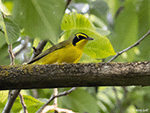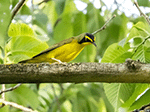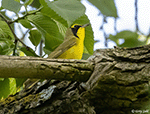| Length: 5.25 inches | Wingspan: 8.25 inches | Seasonality: Rare Migrant / Summer |
| ID Keys: Yellow underparts, olive upperparts, yellow "spectacles" surrounded by black on the crown and below on the face. | ||
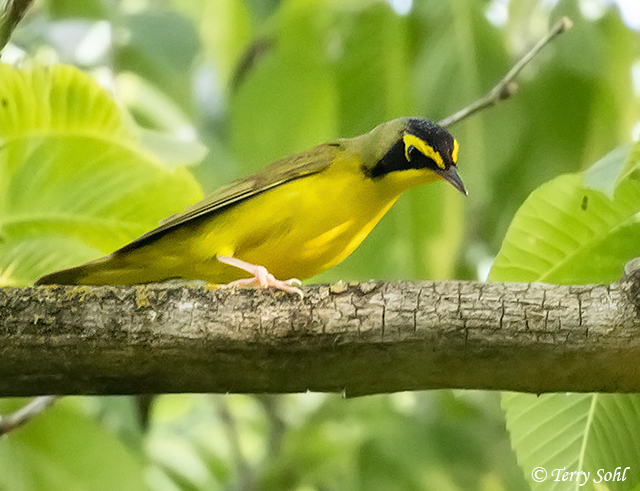 The Kentucky Warbler is
primarily found in deciduous forests of the southeastern United States, usually
near a water source. They spend most of their time foraging on the forest
floor, where they can be difficult to spot because of their shyness, despite
their bright coloring. While the core of the breeding range is to the
south and east of South Dakota, summer specimens have been sighted in the
extreme southeastern part of the state, although no confirmed breeding records
exist (see SDOU's "Birds of South Dakota"). In fact the bird
photographed to the right and below was one that was first found in
Newton Hills State Park in May of
2020, and was still being sighted in the park at least into July.
The Kentucky Warbler is
primarily found in deciduous forests of the southeastern United States, usually
near a water source. They spend most of their time foraging on the forest
floor, where they can be difficult to spot because of their shyness, despite
their bright coloring. While the core of the breeding range is to the
south and east of South Dakota, summer specimens have been sighted in the
extreme southeastern part of the state, although no confirmed breeding records
exist (see SDOU's "Birds of South Dakota"). In fact the bird
photographed to the right and below was one that was first found in
Newton Hills State Park in May of
2020, and was still being sighted in the park at least into July.
Habitat:
During the summer breeding season, prefers deciduous forests near creeks, rivers, and swamps. Found in lowland forests and second-growth forests in the tropics during the winter.
Diet:
Primarily feed on insects and spiders, and occasionally berries.
Behavior:
Nearly always forages along the forest floor, moving through the leaf litter, turning over leaves and other debris in search of insects.
Breeding:
Possible breeder in extreme southeastern South Dakota, but no confirmed records exist as of this writing. The nest of a Kentucky Warbler is placed on the ground or very close to it, in a clump of vegetation, next to the base of a shrub, or occasionally very low in a small shrub or tree. The nest is constructed with leaves as a base, lined with grasses, hair, and rootlets. The female lays between 3 and 6 eggs and she alone incubates them. The young hatch after 10-12 days, with young fledging from the nest about 9-10 days after hatching.
Song:
Loud rich churry-churry-churry-churry-churry, consisting of between 5 and 8 notes. For me it sounds similar to an Ovenbird, but without the rising volume. Kentucky Warblers also have a chip call.
1Click here to hear the song of a Kentucky Warbler
2Click here to hear the call of a Kentucky Warbler
Migration:
Summers throughout much of the Eastern United States south of the Great Lakes and New England. Winters in southern Mexico, Central America, and extreme northern South America.
Interactive eBird map:
Click here to access an interactive eBird map of Kentucky Warbler sightings
Similar Species:
Kentucky Warblers could potentially be confused with other warblers that are primarily black and yellow, if plumage patterns aren't seen well. The species most likely to be confused with a Kentucky Warbler include:
- Hooded Warbler - Males of both species are yellow underneath, olivish-yellow above, with a black and yellow facial pattern. On a Hooded Warbler, most of the head and throat is black, with a yellow mask. On a Kentucky Warbler, the black is restricted to a black cap, eyeline, and cheek, but they have a yellow throat. Female Hooded Warblers may be confused with female Kentucky Warblers, but the Hooded Warbler has a stronger facial pattern that resembles the male (but fainter).
- Common Yellowthroat - Male Common Yellowthroats have a black mask like a male Kentucky Warbler. However, they lack the black cap of the Kentucky Warbler, and have a white belly as opposed to the yellow belly of a Kentucky Warbler. Females of both species are more plainly marked than the males, but Common Yellowthroats have much less contrast on the face than a female Kentucky Warbler, and also have a white belly compared to the completely yellow underside of a female Kentucky Warbler.
- Wilson's Warbler - Males of both species are yellow underneath, olivish-yellow above, and have a black cap. However, that's the extent of the black on a Wilson's Warbler, while Kentucky Warblers have a black eyeline and cheek. Female Wilson's Warblers are more uniformly yellow than female Kentucky Warblers, and lack the relatively strong facial pattern of a Kentucky Warbler.
Conservation Status:
Systematic surveys show that Kentucky Warbler populations have experienced slight declines in recent decades. However, they are still found across a very broad geographic area, and are common in parts of that range. The IUCN considers the Kentucky Warbler to be a species of "Least Concern".
South Dakota "Hotspot":
Most South Dakota sightings of this species have been either at Newton Hills State Park or Union Grove State Park in the extreme southeastern edge of the state.
Further Information:
1) American Bird Conservancy - Kentucky Warbler
2) WhatBird - Kentucky Warbler
3) Audubon Guide - Kentucky Warbler
Photo Information:
June 11th, 2020 - Newton Hills State Park - Terry Sohl
Audio File Credits:
1Don Gorney. Recorded in Vigo County, Indiana on May 12th, 2020. Original recording and information from xeno-canto.
2Hans Matheve. Recorded in Costa Rica on January 31st, 2019. Original recording and information from xeno-canto.
| Click on the map below for a higher-resolution view |
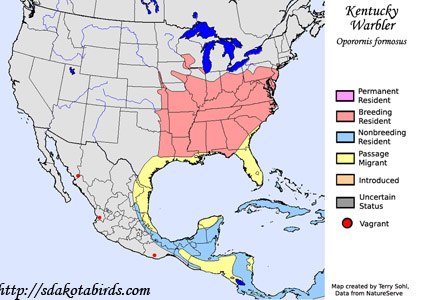 |
| South Dakota Status: Casual migrant and summer resident in the extreme southeastern corner of the state. Summer records in suitable habitat suggest possible breeding, but no breeding has been confirmed in South Dakota. |
Additional Kentucky Warbler Photos
